
Shiraz
Shiraz, the capital of Fars Province in southern Iran, is renowned for its rich history, cultural significance, and stunning architectural heritage. Often referred to as the city of poets, literature, wine, and flowers, Shiraz is a vital cultural center in Iran. The city boasts several UNESCO World Heritage sites, each highlighting its historical and cultural grandeur.

Here are some notable UNESCO sites in and around Shiraz:
Persepolis
Persepolis, also known as Takht-e Jamshid, is one of the most significant archaeological sites in Iran. This ancient ceremonial capital of the Achaemenid Empire is located about 60 kilometers northeast of Shiraz and is a UNESCO World Heritage site.
- Historical Significance: Founded by Darius the Great in 518 BCE, Persepolis was the center of the Persian Empire and a symbol of its glory and power.
- Architectural Marvels: The site features monumental staircases, exquisite reliefs, and imposing gateways. Key structures include the Apadana Palace, the Throne Hall, and the Gate of All Nations.
- Cultural Heritage: The ruins of Persepolis provide a profound insight into the architectural and cultural achievements of the Achaemenid Empire.

Pasargadae
Pasargadae is another UNESCO World Heritage site located about 130 kilometers from Shiraz. It was the first dynastic capital of the Achaemenid Empire, founded by Cyrus the Great in the 6th century BCE.
- Tomb of Cyrus the Great: The most iconic monument at Pasargadae is the tomb of Cyrus the Great, which is a simple yet majestic structure, reflecting the architectural style of the early Achaemenid period.
- Palaces and Gardens: The site includes the remains of several palaces and a royal garden, known as the “Paradise Garden,” showcasing the early Persian garden design that influenced later garden designs in the region.
- Archaeological Significance: Pasargadae provides valuable insights into the early Achaemenid architecture and the empire’s administrative and ceremonial practices.

Eram Garden (Bagh-e Eram)
Eram Garden, located in Shiraz, is one of the nine Persian Gardens that are collectively inscribed as a UNESCO World Heritage site. This beautiful garden is a prime example of Persian garden design and is renowned for its stunning layout and lush vegetation.
- Design and Layout: Eram Garden features a traditional quadripartite layout, with a central pool and pathways dividing the garden into four sections. The garden is filled with various plant species, creating a lush and serene environment.
- Eram Palace: The garden is also home to the Eram Palace, an elegant Qajar-era building that adds to the garden’s charm and historical significance.
- Cultural Importance: Eram Garden is a popular destination for both locals and tourists, offering a tranquil retreat and a glimpse into the sophisticated garden design of ancient Persia.

Tomb of Hafez (Hafezieh)
While not a UNESCO World Heritage site, the Tomb of Hafez is a significant cultural landmark in Shiraz, dedicated to the famous Persian poet Hafez. The tomb and its surrounding gardens attract numerous visitors who come to pay homage to the poet and enjoy the serene ambiance.
- Architectural Beauty: The tomb features a beautiful pavilion with a domed roof, supported by intricately carved columns. The surrounding gardens are meticulously maintained, providing a peaceful setting for reflection and admiration.
- Literary Significance: Hafez is one of Iran’s most beloved poets, and his works are an integral part of Persian literature and culture. The tomb serves as a cultural hub where poetry lovers gather to celebrate his legacy.

Conclusion
Shiraz and its surrounding regions offer a wealth of historical and cultural treasures that are recognized by UNESCO. From the awe-inspiring ruins of Persepolis and Pasargadae to the serene beauty of Eram Garden, these sites provide a deep insight into Iran’s rich heritage. Exploring these landmarks allows visitors to connect with the ancient past and appreciate the cultural achievements that have shaped the region. Shiraz stands as a testament to the enduring legacy of Persian civilization, inviting all who visit to immerse themselves in its history and beauty.

